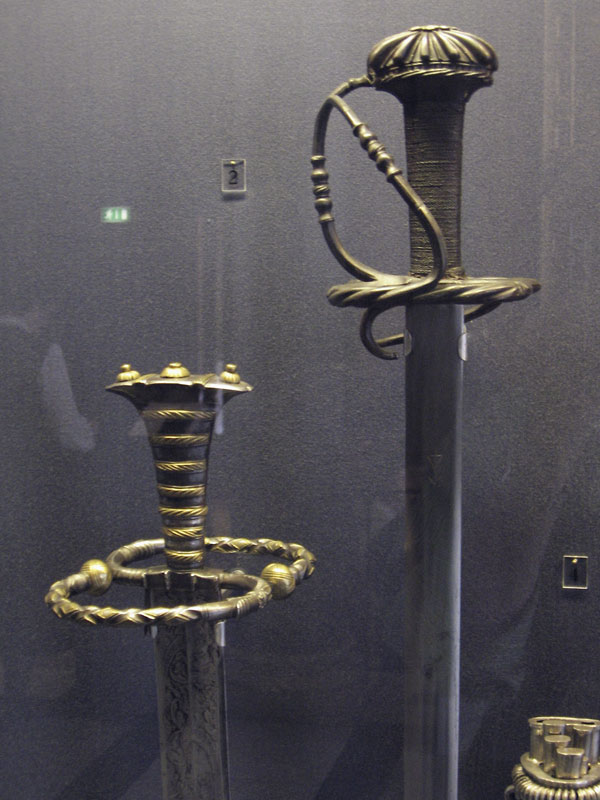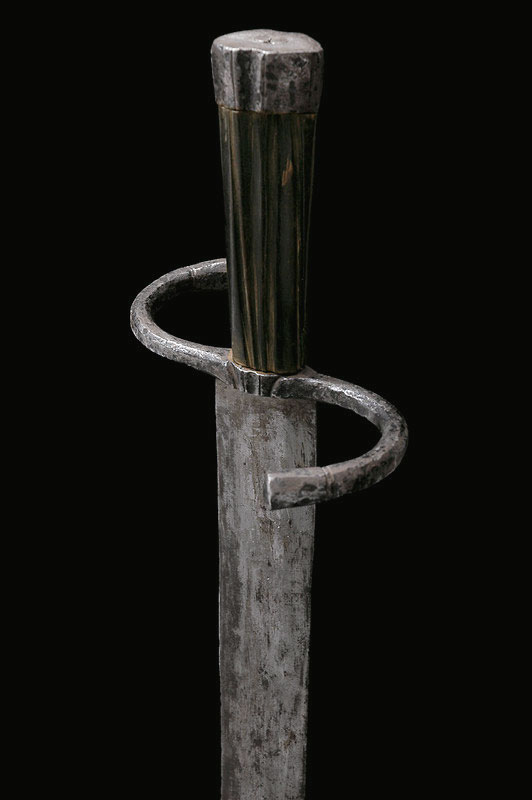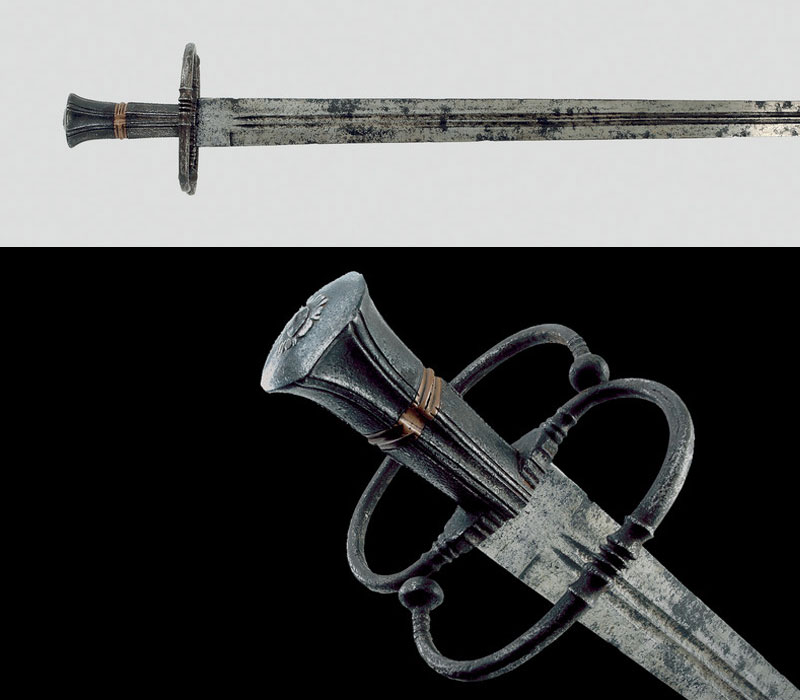| Author |
Message |
|
Anders Backlund
|
 Posted: Sat 31 Mar, 2012 8:50 am Post subject: A question about katzbalgers Posted: Sat 31 Mar, 2012 8:50 am Post subject: A question about katzbalgers |
 |
|
Something I've been wondering about for some time now: I've noted that a lot of katzbalgers and landsknecht type swords have what I tend to think of as "upside down hilts" - grips that taper towards the guard rather then the pommel. Example:

This is the direct opposite of the sort of "fish tail" ergonomy I've come to expect from most sword hilts, but since this style of hilt was so popular with this particular family of swords, I figure there has to be some practical purpose to the design. I am very curious about this since sword ergonomy is of particular interest to me, but alas I have never handled a katzbalger so I can't make any evaluations of my own.
So my question is: Were these hilts meant to be gripped and handled in a certain way (in the same sense that, for example, viking swords or rapiers were), an alternative style produced by landsknecht fashion, or both?
(I have seen similar shapes on other sword types: hangers and so on. But it seems particularly associated with katzbalgers.)
The sword is an ode to the strife of mankind.
"This doesn't look easy... but I bet it is!"
-Homer Simpson.
|
|
  |
 |
|
Justin King
Industry Professional
|
 Posted: Sat 31 Mar, 2012 1:37 pm Post subject: Posted: Sat 31 Mar, 2012 1:37 pm Post subject: |
 |
|
It seems to be a stylistic preference to me, it is a trait that is notable on many Landsknecht daggers also but is not really unique. It is also to be seen on most ballock daggers, some rondel daggers, many eared daggers, and earlier versions of the Scottish Dirk, to name a few examples.
Some authors have noted this trait on daggers and commented that in some cases it is so extreme that it is nearly impossible to hold the weapon in any fashion other than the upside-down icepick type grip, which is obviously not the case with a sword.
It can actually provide a comfortable grip, the basic design principle can be seen on a lot of modern custom knives as well as historical examples.
|
|
  |
 |
Sean Flynt

|
|
   |
 |
|
Anders Backlund
|
 Posted: Sun 01 Apr, 2012 4:50 pm Post subject: Posted: Sun 01 Apr, 2012 4:50 pm Post subject: |
 |
|
| Justin King wrote: | It seems to be a stylistic preference to me, it is a trait that is notable on many Landsknecht daggers also but is not really unique. It is also to be seen on most ballock daggers, some rondel daggers, many eared daggers, and earlier versions of the Scottish Dirk, to name a few examples.
Some authors have noted this trait on daggers and commented that in some cases it is so extreme that it is nearly impossible to hold the weapon in any fashion other than the upside-down icepick type grip, which is obviously not the case with a sword.
It can actually provide a comfortable grip, the basic design principle can be seen on a lot of modern custom knives as well as historical examples. |
Still, knives are very different from swords. I don't think one can make a very accurate assumption about how a sword handles just by comparing it to a knife or dagger. (Unless the sword is so small and the knife so large that their practical applications overlap.) At any rate, I can't imagine anyone using a katzbalger in the same manner as a dagger.
To clarify, I'm mostly asking people who have actually handled these swords or are otherwise knowledgeble about their use. I mean, if it comes down to guessing, I can do that on my own.
| Sean Flynt wrote: | | many longswords have lower grips of the same form but nobody thinks it's odd or awkward. if it looks so on single-hand swords that's probably more to do with the narrow popular image of the sword that forms the first impression of swords for most of us. |
That does not actually answer my question, though. I don't really have any opinion of this type of hilt - that's sort of the whole point of this thread.
The sword is an ode to the strife of mankind.
"This doesn't look easy... but I bet it is!"
-Homer Simpson.
|
|
  |
 |
|
Scott Woodruff
|
 Posted: Sun 01 Apr, 2012 10:02 pm Post subject: Posted: Sun 01 Apr, 2012 10:02 pm Post subject: |
 |
|
|
Perhaps the best way to answer your question would be to buy a 2x4, cut it into 2 or 3 foot lengths and carve some grips of different shapes on one end. Then swing them around and hit stuff with them until you develop an opinion. Ultimately, that is what it comes down to when we talk about some of the variations of weaponry, we each have our own preferences, opinions and comfort zones based on our individul training, physique etc. I personally find grips shaped like those on these katzbalgers to be very comfortable. The expanding grip serves the same purpose as a pommel. I don't find there to really be much of a difference from a biomechanical standpoint vis-a-vis a typical grip with a pommel. YMMV.
|
|
  |
 |
|
Aleksei Sosnovski
|
 Posted: Mon 02 Apr, 2012 12:19 am Post subject: Posted: Mon 02 Apr, 2012 12:19 am Post subject: |
 |
|
|
I have multiple swords with such grips and find them more comfortable (if done correctly of course) than "normal" grips. Swords with "normal" grips tend to slip away from the hand until they are stopped by a pommel which might be an issue if a sword with a longer grip is wielded without a gauntlet, "reverse tapering" grips are less prone to slip away.
|
|
   |
 |
|
Justin King
Industry Professional
|
 Posted: Mon 02 Apr, 2012 6:14 am Post subject: Posted: Mon 02 Apr, 2012 6:14 am Post subject: |
 |
|
| Anders Backlund wrote: |
Still, knives are very different from swords. I don't think one can make a very accurate assumption about how a sword handles just by comparing it to a knife or dagger. (Unless the sword is so small and the knife so large that their practical applications overlap.) At any rate, I can't imagine anyone using a katzbalger in the same manner as a dagger.
To clarify, I'm mostly asking people who have actually handled these swords or are otherwise knowledgeble about their use. I mean, if it comes down to guessing, I can do that on my own. |
That was not a guess, but thank you for making the assumption.
You chose to ask your question on a discussion forum instead of making the effort to answer it yourself. If you wish to discriminate between who is or isn't qualified to answer your question then please make that clear as part of the question.
I'm sure you'll find the answer you are looking for. Regards.
Last edited by Justin King on Mon 02 Apr, 2012 9:59 am; edited 1 time in total
|
|
  |
 |
Nathan Robinson
myArmoury Admin


|
|
    |
 |
|
David G Lawlor
Location: CANADA Joined: 05 Dec 2011
Posts: 7
|
 Posted: Wed 04 Apr, 2012 7:39 pm Post subject: Posted: Wed 04 Apr, 2012 7:39 pm Post subject: |
 |
|
Perhaps the problem rests on the definition of what made up a "Katzbalger".
It is my understanding that the original "cat-gutter" was a secondary weapon to be used in the press when a primary hafted weapon (pike or halberd) was either lost or unusable because of the congestion. As such a Katzbalger was very short and heavy in the blade, and used like a cleaver in close-action overhand blows.
However, it seems now that any sword with figure eight arms of the guard is called a Katzbalger even when it has a longer blade length. In fact, it may be the case that the figure eight fashion was one common to 16th century Germany and its appearance in other swords was just that - a common fashion - and it may not be correct to call that sword a Katzbalger because of it.
I have a five foot Beidenhander that was originally sold as having "Katzbalger guards". Just goes to show you how so many of these things defy strict category.
|
|
  |
 |
|
Scott Woodruff
|
 Posted: Thu 05 Apr, 2012 5:35 pm Post subject: Posted: Thu 05 Apr, 2012 5:35 pm Post subject: |
 |
|
|
As far as I know, only the short weapon is really a Katzbalger. The longer weapons are just swords with figure-8 guards.
|
|
  |
 |
|
Kalle Kylmänen
|
 Posted: Wed 03 Oct, 2012 2:58 pm Post subject: katzbalger pommel types Posted: Wed 03 Oct, 2012 2:58 pm Post subject: katzbalger pommel types |
 |
|
I think having our discussion not spread over to umpteen different threads is a good thing, so I won't make new thread. Still very much related to katzbalger hilts..
Having looked at some extant and reproduction katzbalgers (the must typical, with S-curve quilons etc.), I have seen (atleast) two different types or families of pommels. Firstly, there are the mushroom/fistahil-esque pommels, wich also seems to be quite popular in reproductions.
http://www.myArmoury.com/albums/photo/1646.html
http://www.myArmoury.com/albums/photo/1077.html
The following Include the same elements, but with a different silhouette. These are found on what Sean called a proto-katzbalger, although I could call the second one a fully developed, albeit slender hilted katzbalger.


Photos posted by Nathan on the other katzbalger thread here: http://www.myArmoury.com/talk/viewtopic.php?t=22729
The second type that seems to be frequent has a more pronounced pommel, that doesnt folloe the cross section of the hilt.
http://www.myArmoury.com/albums/photo/1084.html
http://www.myArmoury.com/albums/photo/1087.html
http://www.myArmoury.com/albums/photo/1098.html
The latter style is less familiar to me, partially because I don't remember ever seeing a reproduction of this style. My first question was wether one earlier than the other. I didn't find dates for most of these swords so I couldn't be sure.
Here's some more pictures of the types in same pictures. Actually in the first picture we see a more complex hilt structure on the sword with the distinguishable, separate pommel. This led me to wonder wether to more pronounced pommel could be slightly latter. Also, we have some quite early examples of the proto-mushroom pommel.
http://www.myArmoury.com/talk/files/katzbalger004_110.jpg
http://www.myArmoury.com/talk/files/landsknechtswords_102.jpg
The leftmost weapon on the last picture appears to be a hauswer (the pommel is wooden) seen in Seans thread where he reviewed his splendid hauswer.
Next Iooked a some woodcuts going through our album and these http://st-max.org/images-people.htm
Most of these images seem to depict early or "golden age" landsnechts, by wich I mean before plunderhosen came into fashion. In these pictures the fishtail type is seen in almost every case. Actually the only short sword without such a blade in these galleries after my quick search is this one:

The pommel is closer to the second type of pommels, but still a bit different from the extant examples I linked. The pommel in the picture is more symmetric and doesn't flare towards it's bottom.
Does anyone know more about these pommels (as seen below) that seem to be so rare in early 16th century?
http://www.myArmoury.com/albums/photo/1084.html
|
|
  |
 |
|
|

